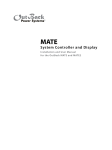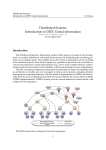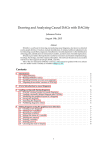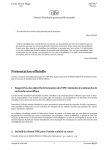Download DIET Tutorial
Transcript
DIET Tutorial
Raphaël Bolze, Eddy Caron, Philippe Combes, Holly Dail and Christophe Pera
INRIA Rhone-Alpes
1
Introduction
This is a tutorial for DIET (Distributive Interactive Engineering Toolbox). It comes with three directories :
exercise2, exercise3 and solutions. The exercise directories contain the skeletons for the programs you
will have to write, solutions contains the solutions to the exercises.
2
Exercise 1 : Installing and compiling DIET
The installation process is described in full in the User’s Manual. In the following section we provide a quick start
guide. Install DIET in the directory of your choice, for instance ${HOME}/DIET. For this tutorial, FAST will not
be used, and as regards omniORB, please add the ${OMNIORB HOME}/bin directory in your PATH, or give the
following option to the configure script : --with-omniORB=${OMNIORB HOME}
2.1
2.1.1
Dependencies
Hardware dependencies
DIET has fully tested on Linux i386 and i686 platforms and has tested on Solaris/Sparc, Linux/Sparc, Linux/i64,
Linux/amd64 and Linux/Alpha platform and seems to be supported.
If you found a bug in DIET, please submit a bug report at http://graal.ens-lyon.fr/bugzilla. If you
have multiple bugs to report, please make multiple submissions, rather than submitting multiple bugs in one report.
2.1.2
Software dependencies
CORBA is used for all communications inside the platform. So all of the three parts depend on it. The implementations of CORBA currently supported in DIET are :
– omniORB 3 which depends on Python 1.5
– omniORB 4 which depends on Python 2.1 or later, and on OpenSSL if you would like your DIET platform to
be secure.
We strongly recommend omniORB 4, as it is easier to install, and provides SSL support.
So far, only one CORBA service is needed : the Naming Service. This service is provided by a name server that
must be launched before all DIET entities. Then, DIET entities must be passed a reference to the <host :port>
of your name server. Later you will have to define the following environment variables ($OMNIORB CONFIG and
$OMNINAMES LOGDIR), and/or, for omniORB 4 only, at compile time, with the --with-omniORB-config and
--with-omniNames-logdir options.
NB : We have noticed that some problems occur with Python 2.3 : the C++ code generated could not be compiled. It
has been patched in DIET, but some warnings still appear.
c 2004 by the author(s)
GridUse 2004, Supélec, France
DIET Tutorial
GridUse 2004
83
Since omniORB needs a thread-safe management of exception handling, compiling DIET with gcc requires at least
gcc3.
Some examples provided in the DIET sources depend on the BLAS and ScaLAPACK libraries. However theses
examples do not have to be compiled.
2.2
Compiling the platform
Once all dependencies are satisfied, untar the DIET archive and change to its root directory. A configure script will
prepare DIET for compiling : its main options are described below, but please, run configure --help to get an
up-to-date and complete usage description.
∼> tar xzf DIET 1.1.tgz
∼> cd DIET
∼/DIET> ./configure --help=short
Configuration of DIET 1.1 :
...
2.2.1
Optional features for configuration
--disable-FEATURE
do not include FEATURE (same as --enable-FEATURE=no)
--enable-FEATURE[=ARG] include FEATURE [ARG=yes]
--enable-maintainer-mode enable make rules and dependencies not useful
(and sometimes confusing) to the casual installer
--enable-doc
enable the module doc, documentation about DIET
This option activates the compilation and installation of the DIET documents, which is disabled by default, because it
is very sensitive to the version of your LATEX compiler. The output postscript files are provided in the archive.
--disable-examples
disable the module examples, basic DIET examples
This option deactivates the compilation of the DIET examples, which is enabled by default.
--enable-BLAS
enable the module BLAS, an example for calling BLAS
functions through DIET
This option activates the compilation of the DIET BLAS examples, as a sub-module of examples (which means that
this option has no effect if examples are disabled) - disabled by default.
--enable-logservice
enable monitoring through LogService
This option enables the connection from DIET to the LogService monitoring software. It will enable DIET to generate
monitoring data and send it to the LogService. Note that the support of LogService is built in. You do not have to install
the LogService package to compile with this option.
--enable-ScaLAPACK
enable the module ScaLAPACK, an example for calling
ScaLAPACK functions through DIET
This option activates the compilation of the DIET ScaLAPACK examples, as a sub-module of examples (which means
that this option has no effect if examples are disabled) - disabled by default.
--enable-Cichlid
enable generation of communication logs for Cichlid
--enable-stats
enable generation of statistics logs
--enable-multi-MA
enable multi-MA architecture
--disable-dependency-tracking Speeds up one-time builds
--enable-dependency-tracking Do not reject slow dependency extractors
--enable-shared=PKGS
build shared libraries default=yes
--enable-static=PKGS
build static libraries default=yes
--enable-fast-install=PKGS optimize for fast installation default=yes
--disable-libtool-lock avoid locking (might break parallel builds)
84
GridUse 2004
2.2.2
Bolze, Caron, Combes, Dail and Pera
Optional packages for configuration
--with-PACKAGE[=ARG]
--without-PACKAGE
--with-gnu-ld
--with-pic
use PACKAGE [ARG=yes]
do not use PACKAGE (same as --with-PACKAGE=no)
assume the C compiler uses GNU ld default=no
try to use only PIC/non-PIC objects default=use both
omniORB
--with-omniORB=DIR
specify the root installation directory of omniORB
--with-omniORB-includes=DIR
specify exact header directory for omniORB
--with-omniORB-libraries=DIR
specify exact library directory for omniORB
--with-omniORB-extra=ARG|"ARG1 ARG2 ..."
specify extra conftest.c -o conftest for the linker
to find the omniORB libraries (use "" in case of
several conftest.c -o conftest)
This group of options lets the user define all necessary paths to compile with omniORB. Generally,
--with-omniORB=DIR should be enough, and the other options are provided for ugly installations of omniORB.
NB : having the executable omniidl in the PATH environment variable should be enough in most cases.
FAST
--with-FAST=DIR
--with-FAST-bin=DIR
installation root directory for FAST (optional)
installation directory for fast-config (optional)
This group of options lets the user define all necessary paths to compile with FAST. Generally, --with-FAST=DIR
should be enough, and the other options are provided for difficult installations of FAST. There is no need to specify
includes, libraries and extra arguments, since FAST provides a tool fast-config that does this job automatically.
NB1 : having the executable fast-config in the PATH environment variable should be enough in most cases.
NB2 : it is possible to specify --without-FAST, which overrides fast-config detection.
BLAS The BLAS 1 (Basic Linear Algebra Subprograms) are high quality ”building block” routines for performing
basic vector and matrix operations. Level 1 BLAS do vector-vector operations, Level 2 BLAS do matrix-vector operations, and Level 3 BLAS do matrix-matrix operations. Because the BLAS are efficient, portable, and widely available,
they’re commonly used in the development of high quality linear algebra software.
--with-BLAS=DIR
specify the root installation directory of BLAS (Basic
Linear Algebric Subroutines)
--with-BLAS-includes=DIR
specify exact header directory for BLAS
--with-BLAS-libraries=DIR
specify exact library directory for BLAS
--with-BLAS-extra=ARG|"ARG1 ARG2 ..."
specify extra conftest.c -o conftest for the linker to find
the BLAS libraries (use "" in case of several
conftest.c -o conftest)
This group of options lets the user define all necessary paths to compile with the BLAS libraries. Generally,
--with-BLAS=DIR should be enough, and the other options are provided for difficult installation of the BLAS.
NB : these options have no effect if the module example and/or its sub-module BLAS are disabled.
ScaLAPACK The ScaLAPACK2 (or Scalable LAPACK) library includes a subset of LAPACK routines redesigned
for distributed memory MIMD parallel computers. It is currently written in a Single-Program-Multiple-Data style using
explicit message passing for interprocessor communication. It assumes matrices are laid out in a two-dimensional block
cyclic decomposition.
1 http://www.netlib.org/blas/
2 http://www.netlib.org/scalapack/
DIET Tutorial
GridUse 2004
85
Like LAPACK, the ScaLAPACK routines are based on block-partitioned algorithms in order to minimize the frequency of data movements between different levels of the memory hierarchy. (For such machines, the memory hierarchy includes the off-processor memory of other processors, in addition to the hierarchy of registers, cache, and
local memory on each processor.) The fundamental building blocks of the ScaLAPACK library are distributed memory
versions (PBLAS) of the Level 1, 2 and 3 BLAS, and a set of Basic Linear Algebra Communication Subprograms
(BLACS) for communication tasks that arise frequently in parallel linear algebra computations. In the ScaLAPACK
routines, all interprocessor communication occurs within the PBLAS and the BLACS. One of the design goals of
ScaLAPACK was to have the ScaLAPACK routines resemble their LAPACK equivalents as much as possible.
--with-ScaLAPACK=DIR
specify the root installation directory of ScaLAPACK
(parallel version of the LAPACK library)
--with-ScaLAPACK-includes=DIR
specify exact
--with-ScaLAPACK-libraries=DIR
specify exact
--with-ScaLAPACK-extra=ARG|"ARG1 ARG2
specify extra
the ScaLAPACK
conftest.c -o
header directory for ScaLAPACK
library directory for ScaLAPACK
..."
conftest.c -o conftest for the linker to find
libraries (use "" in case of several
conftest)
This group of options lets the user define all necessary paths for compilation with the ScaLAPACK libraries.
Normally, --with-ScaLAPACK=DIR could be enough, but the other options are provided because the installation of the ScaLAPACK libraries is often difficult, and thus difficult to detect automatically. For instance, the
--with-ScaLAPACK-extra option is useful to integrate BLACS and MPI libraries, which are useful for ScaLAPACK.
NB : these options have no effect if the module example and/or its sub-module ScaLAPACK are disabled.
2.2.3
From configuration to compilation
An important option for configure scripts is --prefix=, which specifies where binary files, documents and configuration files will be installed. It is important to set this option : it otherwise defaults to DIET/install.
The configuration will return with an error if no ORB was found. So please help the configure script to find the
ORB with the --with-omniORB* options.
If everything went OK, the configuration ends with a summary of the options that were selected and what it was
possible to get. The output will look like :
˜/DIET > ./configure --enable-doc --enable-BLAS
DIET successfully configured as follows:
- documents:
yes
- examples:
dmat_manips, file_transfer, scalars
- FAST:
found /home/username/DIET/FAST/bin/fast-config
- ORB:
omniORB 4 in /usr
- prefix:
/home/username/DIET/install
- multi-MA:
no
- LogService:
no
- target platform: i686-pc-linux-gnu
Please run make help to get compilation instructions.
˜/DIET > make help
====================================================================
Usage : make help
: shows this help screen
make agent
: builds DIET agent executable
make SeD
: builds DIET SeD library
make client
: builds DIET client library
make examples : builds basic examples
make
: builds everything configured
make install : copy files into /home/username/DIET/install
====================================================================
This helps the user to choose the DIET parts for installation and compilation. It is recommended for beginners to
compile the client, the SeD and the agent in one single step with make all. But please, pay attention to the fact that
make all does not install DIET in the prefix provided at configuration time. To do this, run make install.
86
GridUse 2004
Bolze, Caron, Combes, Dail and Pera
make install will run the compilation for all DIET entities before the installation itself. Thus, if the user wants
to compile only the agent, for instance, and install it, he must run :
˜/DIET > cd src/agent
˜DIET/src/agent > make install
3
Exercise 2 : An example of matrix computation
With this example we learn how to program a simple client/server application that uses DIET. We will use the context
of matrix computation to make this program more realistic. We will implement a basic scalar by matrix product. Then,
we will test this program in different execution schemes.
3.1
File skeletons
The exercise2 directory, located in your home directory contains all the skeleton files needed for a quick start. Useful
pieces of software are also included in them. This directory contains the following files :
Makefile management of dependencies between source and compiled files
server.c program implementing the service (scalar by matrix product)
client smprod.c program using the service defined in server.c : the matrix is stored in memory
client smprod file.c same program as client smprod.c, except that the matrix is passed as a file to the server
3.2
Server-side implementation
Using the skeleton of program server.c, write a service of scalar by matrix product. This service will have the
following parameters :
parameter
a scalar
a matrix to be multiplied
the time needed for the product to compute
type
double
double
float
The intial matrix is overwritten by the result. The matrix will be stored in memory.
To start, try to define a detailed interface for the service, i.e. a precise definition of the service profile. To do so, look
for in, inout and out parameters.
Next, program the solve function solve smprod, and also the initialization of the service in the main function.
int solve_smprod(...) {
}
The following function is given to help you :
int scal_mat_prod(double alpha, double *M, int nb_rows, int nb_cols, float *time)
It mutliplies the scalar alpha by the matrix M a nb rows by nb cols matrix. The results are the matrix alpha
× M and the time of this operation in seconds.
3.3
Client-side implementation
Using the client smprod.c skeleton file, write a client for the service defined above. You will need to initialize
a matrix and a scalar with known values. That way, you will be able to verify if the answer is correct or not.
You will have to remember that the profile used in the client must match exactly the server profile.
DIET Tutorial
3.4
GridUse 2004
87
Setting up and testing the client/server
The file env vars.bash.in for bash shell (respectively env vars.csh.in for tcsh shell) contains all the
environment variables needed for the execution of the programs. Verify the values of those variables, then load this file
using the following method :
˜/> source env_vars.bash
When done with this operation, you need to start the name server of omniORB : omniNames. To do that, you must
give a port number with the -start option, on which the service will be opened (and on which the server “listens”) :
$ omniNames -start <port>
Tue Dec 11 14:10:28 2003:
Starting omniNames for the first time.
Wrote initial log file.
Read log file successfully.
Root context is
IOR:010000002b00000049444c3a6f6d672e6f72672f436f734e616d696e672f4e616d696e674
36f6e746578744578743a312e300000010000000000000060000000010102000d000000313430
2e37372e31332e36310000554f0b0000004e616d6553657276696365000200000000000000080
000000100000000545441010000001c0000000100000001000100010000000100010509010100
0100000009010100
Checkpointing Phase 1: Prepare.
Checkpointing Phase 2: Commit.
Checkpointing completed.
$
Then, you have to copy this port number in the omniORB configuration file : the name and location of this file is
given by the environment variable OMNIORB CONFIG which is defined in the env vars.bash file.
Using the examples configuration files found in $DIET HOME/src/examples/cfgs write your own configuration files (suggestion : place them in a cfgs directory). You will want to create a hierarchy of agents to make it
interesting. This hierarchy should contain at least one MA and one LA.
Compile server and client with the Makefile, then, launch the server and the client.
Finally, launch several servers in different windows (you can use same or different distributed computers). With
different windows, you will see which one is activated. You should experiment with different hierarchies.
3.5
Another version of the service
In this part, you will modify the server to make it support a slightly different version of the scalar by matrix product.
The matrix will be transmitted as a file, and not anymore in memory.
DIET doesn’t impose anything about the data format of files, but it would be a good idea to facilitate your work to
use the data format used in the skeleton files. This format is just simple text : the file contains a series of numbers,
separated by ’space’ characters. The meaning of the numbers is as follows :
– matrix dimensions (number of rows, number of columns)
– matrix values
Create a file containing a matrix, then implement a new service “smprod file” with the following parameters :
parameter
a scalar
a file containing matrix to be multiplied
the time needed for the product to compute
type
double
double
float
The file is overwritten by the result.
4
Exercise 3 : yet another service : The BLAS dgemm
To compile programs of this exercise, the BLAS library (Basic Linear Algebric Subroutines) is required. You also
should have configured DIET with --enable-BLAS option.
88
GridUse 2004
Bolze, Caron, Combes, Dail and Pera
DGEMM - perform one of the matrix-matrix operations C := alpha*op( A )*op( B ) + beta*C
The dgemm function is part of the BLAS. It performs the following matrix-matrix computation :
C := αAB + βC
α and β are scalars, and A, B and C are matrices, with op( A ) an m by k matrix, op( B ) a k by n matrix and C an m
by n matrix
This exercise aims at adding a new service in a DIET platform, that performs the dgemm computation. The idea is
to interface the existing dgemm function to a DIET SeD. Here is its prototype :
void dgemm_(char
char
int
int
int
double
double
int
double
int
double
double
int
*tA,
*tB,
*m,
*n,
*k,
*alpha,
*A,
*lda,
*B,
*ldb,
*beta,
*C,
*ldc);
All parameters are given by address. Parameters alpha, beta, m, n, k, A, B and C correspond exactly to their
respective roles in the computation. lda, ldb and ldc are the leading dimensions of the corresponding matrices.
Since matrices are stored in a classical one-dimension array, it is important to specify if they are stored by rows or by
columns. *tA and *tB are characters which have the following semantics :
tA
’T’
’N’
Storage order of A (m,k)
row-major
[row 1, row 2, ... , row m]
column-major [col 1, col 2, ... , col k]
For this exercise, there is no need to explore all possibilities offered by the storage order or the leading dimension.
Just set *tA and *tB to ’N’, and lda, ldb and ldc to the number of rows of the corresponding matrix.
Once you have specified the profile of the service, program a server that implements this service, and a test client,
using the file skeletons in the exercise3 directory. Matrices will be stored in memory. Eventually, test the client/server
architecture, through DIET, in different contexts of execution.


























